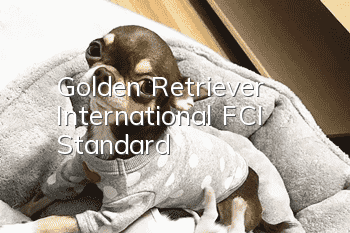Golden Retriever International (FCI) Standard

Golden Retriever’s FCI number: 111
The FCI group of the Golden Retriever: Group 8: Retrievers, Search Dogs and Water Spaniels
Golden Retriever’s height: Male Golden Retriever’s shoulder height is 22.1-24.0 inches (56.0-61.0 cm), female Golden Retriever’s shoulder height is 20.1-22.1 inches (51.0-56.0 cm)
The weight range of golden retrievers: male golden retrievers weigh 59.5-79.4 pounds (27.0-36.0 kg), female golden retrievers weigh 55.1-70.6 pounds (25.0-32.0 kg)
The head of the golden retriever (head, face, eyes, ears, nose, mouth, muzzle, jaw, teeth)
Head: The brows are clear, the skull is broad, and the skull is connected to the nose and mouth. Nose: Black or brown-black, cold weather may lighten the color. The distance between the eyes is wider. Eyes: Dark brown, dark and bright, widely spaced, moderately sunken, medium in size, drooping above the eyes and close to the cheeks. Ears: short, with the front edge well back, just above the eye, hanging close to the cheek. If pulled forward, the tips of the ears just cover the eyes. Jaws/Teeth: The jaws are strong in a scissors bite, with the inner sides of the upper incisors touching the lower incisors. That is, the upper teeth touch the lower teeth tightly, forming a square shape with the lower jaw. Muzzle: Strong, broad and deep. The length of the front face is approximately equal to the length from the toes to the occipital bone.
Golden Retriever’s trunk (neck, chest, ribs, waist and back, front of body, skin)
Neck: The neck is medium long, strong and muscular. The skin of the throat should not be too loose and sagging. Topline: Strong, level from withers to slightly sloping croup, whether at rest or in motion. Sloping, arched, concave back; flat or too steep croup are faults. Chest: Deep. The width of the chest between the legs is at least equal to the width of an adult man's closed hand (including thumb), and the chest is well developed. The sternum extends to the elbow. The ribs are long and well curvature, but not barrel-shaped, extending well into the hindquarters. Loin: Short, strong, broad and deep, slightly tapered when viewed from the side. Flat sides, narrow chest, lack of chest depth, and excessive waist contraction are all faults.
The limbs of the golden retriever (forehead, shoulders, upper limbs, pastern joints, pasterns, soles of feet, hindquarters, thighs, hocks, joints and hock nails)
Forequarters: Strong, well coordinated with hindquarters, capable of free movement. The shoulder blades are long, well set back, and the tips are close at the withers. The upper arms are about the same length as the shoulder blades; the back of the elbow is directly below the tip of the shoulder blade, close to the ribs without slack. Viewed from the front, the legs should be straight and of sufficient bone, but not thick. The palm is short, strong, slightly sloping, and shows no sign of instability. Pseudomonas is removed, but usually retained.Hindquarters: Broad and well muscled. Viewed from the side, the hips are slightly downward-sloping; the pelvic slope is slightly larger (approximately 30 degrees from the horizontal). In a natural stance, the femur is connected to the pelvis at about 90 degrees; the knee joint is fully bent; the heel joint is fully close to the ground, and the metatarsal bones are short and strong. Feet similar to forefoot. Viewed from behind, the legs are straight. Heels that turn in, turn out, or not straighten are all faults. Feet: Medium size, round, compact, well knuckled, with thick toe pads. If there is excessive hair, it should be trimmed to reveal natural size and contour. Shoulders: Shoulders set back, shoulder blades long. Upper arms: equal in length to the shoulder blades, supporting the legs well. Elbows: Closely articulated. Hocks: When viewed from behind, they are naturally relaxed and straight, neither in nor out. Cow hocks are undesirable.
Golden Retriever’s Tail
Tail: The base of the tail is high, the bottom of the tail is thick and muscular, and it naturally extends the length of the hip line. The tailbone extends to (but not below) the hock joint. The tail is carried cheerfully, in a level or moderate upward curve; it should not be curled over the back or tucked between the legs.
Golden Retriever’s Gait/Movement
When trotting, the gait should be free, smooth, powerful, coordinated, and with sufficient stride length. No matter from which angle you look at it, the legs neither turn in nor turn out, and the feet do not entangle or cross each other. As speed increases, the feet tend to converge on the central balance line. It is recommended that the leash be relaxed to show a natural gait.
Disqualification conditions for golden retrievers
Faults: Any deviation from the above points will be considered a fault, and any dog that is obviously abnormal in body or behavior will be disqualified. Height more than one inch below or above standard height, with a protruding upper or lower jaw.
- What are the early symptoms of canine distemper in dogs?
- Causes and symptoms of demodicosis in dogs
- What to do if your dog at home is vomiting
- What are the black spots on dogs?
- What kind of food do little shepherd dogs eat?
- How much does a silver fox cost and is it easy to raise? How to raise a silver fox and its appearance characteristics
- Seven Tips to Quiet Your Dog Quickly
- English Bulldog personality traits
- How to train a poodle to be well-behaved and lovable?
- What to do if Border Collie vomits



